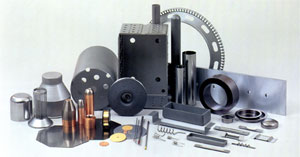Platinum Suppliers
 Platinum is used in chemical, scientific applications across a variety of industries.
Platinum is used in chemical, scientific applications across a variety of industries.
More information about platinum
Platinum is a chemical element with the chemical symbol Pt and an atomic number of 78. Its name is derived from the Spanish term platina del Pinto, which is literally translated into "little silver of the Pinto River." It is in Group 10 of the periodic table of elements. A dense, malleable, ductile, precious, gray-white transition metal, platinum is resistant to corrosion and occurs in some nickel and copper ores along with some native deposits.
Platinum is used in jewelry, laboratory equipment, electrical contacts and electrodes, platinum resistance thermometers, dentistry equipment, and catalytic converters. Platinum bullion has the ISO currency code of XPT. Platinum is a commodity with a value that fluctuates according to market forces. As of 30 October 2009 (2009 -10-30)[update], platinum was worth US$1,324.00 per troy ounce (approximately US$42.57 per gram).
Characteristics
As a pure metal, platinum is silvery-white in appearance, lustrous, ductile, and malleable. It does not oxidize at any temperature, although it is corroded by halogens, cyanides, sulfur, and caustic alkalis. Platinum is insoluble in hydrochloric and nitric acid, but dissolves in aqua regia to form chloroplatinic acid, H2PtCl6.
Platinum's wear- and tarnish-resistance characteristics are well suited for making fine jewelry. Platinum is more precious than gold or silver. Platinum possesses high resistance to chemical attack, excellent high-temperature characteristics, and stable electrical properties. All of these properties have been exploited for industrial applications.
Occurence
Platinum is an extremely rare metal,[18] occurring as only 0.003 ppb in the Earth's crust. It is sometimes mistaken for silver (Ag).
Platinum is often found chemically uncombined as native platinum and alloyed with iridium as platiniridium. Most often the native platinum is found in secondary deposits; platinum is combined with the other platinum group metals in alluvial deposits. The alluvial deposits used by pre-Columbian people in the Chocó Department, Colombia are still a source for platinum group metals. Another large alluvial deposit was found in the Ural Mountains, Russia, which is still mined.
In nickel and copper deposits platinum group metals occur as sulfides (i.e. (Pt,Pd)S)), tellurides (i.e. PtBiTe), antimonides (PdSb), and arsenides (i.e. PtAs2), and as end alloys with nickel or copper. Platinum arsenide, sperrylite (PtAs2), is a major source of platinum associated with nickel ores in the Sudbury Basin deposit in Ontario, Canada. The rare sulfide mineral cooperite, (Pt,Pd,Ni)S, contains platinum along with palladium and nickel. Cooperite occurs in the Merensky Reef within the Bushveld complex, Gauteng, South Africa.[19]
The largest known primary reserves are in the Bushveld complex in South Africa.[20] The large copper–nickel deposits near Norilsk in Russia, and the Sudbury Basin, Canada, are the two other large deposits. In the Sudbury Basin the huge quantities of nickel ore processed makes up for the fact that platinum is present as only 0.5 ppm in the ore. Smaller reserves can be found in the United States,[20] for example in the Absaroka Range in Montana.[21] This is also shown in the production of 2005. In 2005, South Africa was the top producer of platinum with an almost 80% share followed by Russia and Canada.[22]
Platinum exists in higher abundances on the Moon and in meteorites. Correspondingly, platinum is found in slightly higher abundances at sites of bolide impact on the Earth that are associated with resulting post-impact volcanism, and can be mined economically; the Sudbury Basin is one such example.
Production
Platinum together with the rest of the platinum metals is obtained commercially as a by-product from nickel and copper mining and processing. During electrorefining of copper, noble metals such as silver, gold and the platinum group metals as well as selenium and tellurium settle to the bottom of the cell as anode mud, which forms the starting point for the extraction of the platinum group metals.[23][24]
If pure platinum is found in placer deposits or other ores, it is isolated from them by various methods of subtracting impurities. Because platinum is significantly denser than many of its impurities, the lighter impurities can be removed by simply floating them away in a water bath. Platinum is also non-magnetic, while nickel and iron are both magnetic. These two impurities are thus removed by running an electromagnet over the mixture. Because platinum has a higher melting point than most other substances, many impurities can be burned or melted away without melting the platinum. Finally, platinum is resistant to hydrochloric and sulfuric acids, while other substances are readily attacked by them. Metal impurities can be removed by stirring the mixture in either of the two acids and recovering the remaining platinum.[25]
One suitable method for purification for the raw platinum, which contains platinum, gold, and the other platinum group metals, is to process it with aqua regia, in which palladium, gold and platinum are dissolved, while osmium, iridium, ruthenium and rhodium stay unreacted. The gold is precipitated by the addition of iron(III) chloride and after filtering of the gold, the platinum is precipitated by the addition of ammonium chloride as ammonium chloroplatinate. Ammonium chloroplatinate can be converted to the metal by heating.[26]
Applications
Of the 239 tonnes of platinum sold in 2006, 130 tonnes were used for automobile emissions control devices, 49 tonnes were used for jewelery, 13.3 tonnes were used in electronics, and 11.2 tonnes were used by the chemical industry as a catalyst. The remaining 35.5 tonnes produced were used in various other minor applications, such as electrodes, anticancer drugs, oxygen sensors, spark plugs and turbine engines.[27]
Source: Wikipedia.org